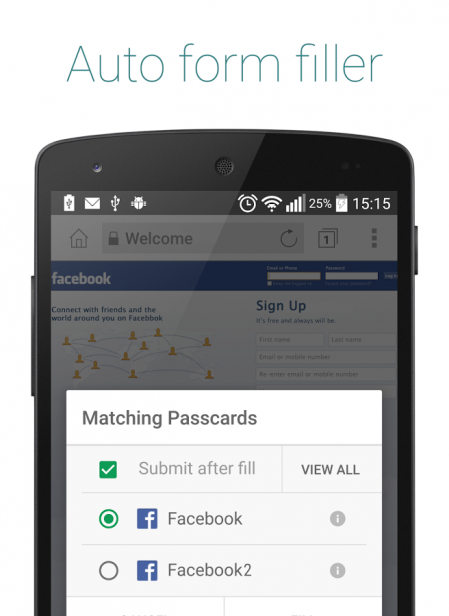RoboForm Review
RoboForm Review
A password manager with a decent mobile app

Verdict
Pros
- Well-designed mobile app
Cons
- Somewhat clumsy desktop interface
- More expensive than LastPass
- Sometimes confusing documentation
Key Specifications
- Review Price: £10.00
- Encrypted online password storage
- Free tier stores passwords for a single device
- RoboForm Everywhere, $19.95 per year
- Applications for Windows, Android, iOS, Windows Phone
- Browser plugins for Microsoft Internet Explorer, Google Chrome/Chromium, Mozilla Firefox, Apple Safari, Opera
What is RoboForm?
RoboForm is a browser, desktop and mobile password manager and automatic form-filling tool. Although it still stores your passwords online, it’s strongly focused around its desktop app. Although it’s a capable tool, the styling and behaviour of both desktop app and browser plugin look a little dated, although this has been improved in version 8, which recently came out of beta.
Related: Why you need a password manager and the best password managers to subscribe to
RoboForm – Features
The free version of RoboForm, as of the service’s latest version 8, works on a single mobile or desktop device, but you’ll have to upgrade to the paid version if you want your passwords to be synced across your devices.
The paid-for RoboForm Everywhere, available on an annual subscription of $19.95 (around £15), lets you run the software on as many devices as you like. RoboForm Everywhere supports basic two-factor authentication, in which an one-time password is emailed to you whenever you add a new device.
Perpetual, single-device licences are also available, at $29.95 (around £23) for an individual desktop PC or $39.95 (around £30) for a USB stick with a portable RoboForm installation on it. It’s worth bearing in mind that the RoboForm2Go portable version isn’t being updated to the software’s current version 8, however, and only works on Windows PCs with Firefox and Internet Explorer.
Related: Best VPNs for Netflix and privacy
The RoboForm browser plugins let you search for, browse and launch sites whose credentials you’ve stored. They can automatically log you into sites and save both new and updated passwords. They’ll also generate passwords to your required criteria on demand, auto-fill forms, save bookmarks, let you manually add login details and can create a custom browser start page to give you easy access to your favourite sites.
However, to use RoboForm’s more advanced features, you’ll need the RoboForm Editor desktop app, which is available for Windows and macOS, but not Linux – browser plugins work under Linux, however. The latest version 8 of the RoboForm Editor desktop application includes newly added features such as the ability to securely share logins via email, a password strength assessment tool and faster syncing times thanks to a new file structure.
Most importantly, the interface has been thoroughly reskinned, making for a much more pleasant user experience, although it still feels clumsy to use in places.
RoboForm has separate sections for Logins, Bookmarks, desktop Applications, Identities – personal information that you wish to store from your National Insurance number to credit card details – Contacts and Safenotes. However, the same set of folders is mirrored across all sections – we’d have preferred to be able to customise the folders in each section, as a Shopping or Entertainment category that’s useful for bookmark or password sorting is of little use when it comes to keeping track of notes or personal information.
RoboForm is sadly a little unclear when it comes to both integrated and online documentation, although the service’s customer support team is helpful and responsive. One of the worst examples of this is the instructions for saving passwords for a local application, which tell you to “open a save password form in an application” without providing any information on how to do this.
However, once we learned that the process required us to first open the login screen of the application, then select Show Toolbar from the right-click menu of RoboForm’s notification area icon, we found that it stored and auto-filled many, but not all, applications’ login details. We’d have preferred to be able to manually add application passwords directly via the RoboForm editor, rather than having to go through multiple clicks and a toolbar to have them saved.
We were pleased by the ease with which we could import passwords from other password managers, and RoboForm’s good habit of checking for duplicate entries during the import process. Although it can import bookmarks from browsers, it was unable to import passwords from Chrome.
RoboForm’s mobile applications for iOS and Android are first and foremost secure mobile browsers, similar to those built into rivals LastPass and Dashlane. They’re well designed, and helpfully auto-suggest websites for which you have stored passwords when you start typing into the URL bar, while a full list of your logins is available from a tab viewer on the browser’s home screen.

As with the desktop app, you can manually create notes, contacts and bookmarks, but can’t manually add login information – this has to be saved directly after you’ve logged into a site in the app for the first time. You can also configure the app to enable form and password filling in other apps on your mobile device. As far as security goes, you can opt for a simple pin to unlock the app, rather than having to enter your full password every time you need it, but bear in mind that this is a somewhat less secure option.
Verdict
While RoboForm works perfectly well as an online and mobile password manager, its overall user experience isn’t as polished that of LastPass, our first choice for password management, and it can’t rival KeePass and its extended family of user-controlled apps and plugins for the ultra-security conscious.


